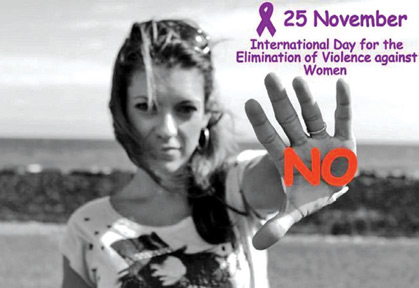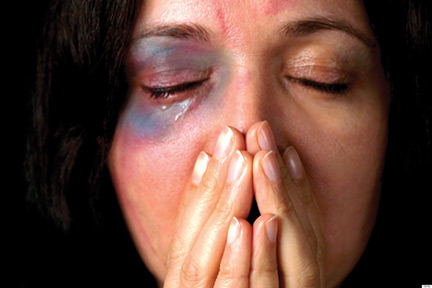|
 International Day for the Elimination of Violence
against Women on Nov 25 : International Day for the Elimination of Violence
against Women on Nov 25 :
Stop the violence NOW!
By Carol Aloysius
In a couple of days, women across the world will take to the streets
and public platforms to air their views on a subject that they have long
been familiar with - so much so that it has become part of their daily
lives: namely, Gender Based Violence (GBV). Living in a world where
almost every fabric of society has been infiltrated by acts of violence,
where civil wars, ethnic conflicts, honour killings, and moral decay
have collectively contributed to the rapid rise of unsafe environments,
women have never been exposed to so much violence as they are today.
This has been borne out by recent studies by researchers,
sociologists and feminists who have not only shocked us out of our
comfort zones with their startling statistics, they have shown us how
violence impacts on women’s health, their personal relationships, their
marriages, their families, and stifles their potential talents and
skills to the country’s development.
Of late, such violence has escalated by leaps and bounds, as
thousands of women caught up in civil war and displaced from their home,
live in refugee camps enduring unbelievable hardships.
Their situation is compounded by the fact that all of them married or
single, old or young, are completely at the mercy of the military
personnel guarding them, who sexually abuse them taking advantage of
their extreme vulnerability. Added to this, is the fact that women now
dominate the labour force in most countries including Sri Lanka.
Although this is a positive reflection of their advancement towards
true emancipation, it also puts them at risk to sexual harassment at
their place of work. The numerous instances reported of female garment
workers in the Free Trade Zones who are sexually abused while returning
home at night, is an example of this rising tide of violence against
women.
Age
Age is no barrier to Gender Based Violence. Newspapers are rife with
instances when even elderly women in their 70s and 80s have been
sexually harassed.
|

Domestic violence victim |
Whether travelling by bus, train a single woman is often marked as
the ideal candidate for eve teasing, vulgar comments and even rape by
the opposite sex. In neighboring India eve teasing recently led to the
death of a university student who couldn’t endure the continued remarks
cast by her own male colleagues.
Similar incidents have been recorded in other countries including Sri
Lanka where a young woman who was stalked by a youth finally turned her
wrath on him by hitting him with her phone and injuring him. Even
travelling on a plane could end up with disastrous results.
From nonagenarians (and even centenarians) to adolescents and girls
still on the brink of attaining menarche, no female it seems is safe
from such abuse today in our society.
The National Child Protection Authority (NCPA) has reported that by
August end this year, the number of complaints it had received for this
year alone on child abuse amounted to 6,973 of which 1,477 were for
violence.
In addition, the NCPA also received 324 complaints of rape and 327
complaints of sexual harassment. Although male children are also
included in these statistics, the girl children who have been abused
sexually outnumber them by far.
Facts
No less startling are the facts and statistics that have emerged from
the most recently researched edition on GBV in Sri Lanka, by the Women’s
Health Committee of the SLMA which sheds light on why and who the
perpetrators of such violence are in most instances.
Abuse - A questionnaire given to female undergraduates after a
lecture on child abuse showed that 12.3 percent of females had been
abused in childhood - their abusers being a brother, uncle or father (De
Silva 1998).
Incest - A study in 2002 conducted through institutions dealing with
victims of incest in the Central Province revealed that the typical
incest victims were girl children below 12, the abusers being an older
family member, often her father, stepfather, uncle or an older brother.
Sexual abuse - Police records of 2003 showed the majority of victims
of grave sexual abuse (seduction, rape, incest and procreation) were 78
percent girls, especially those under 16 (Ministry of Health 2008).
Harassment - Newspaper articles on the nature and magnitude of
harassments to women and girls in Lankan society (Weerakkody and Kumaara
2007) revealed that sexual harassment was most prominent in 88 percent
of under-aged girls, rape being the commonest form of abuse.
Domestic violence
Of all these acts of violence, Domestic Violence (DV) is the most
widely prevalent form of abuse inflicted on women. That this form of
violence occurs mostly within a marriage and is perpetrated within the
four walls of their own homes, is even more tragic.
Domestic violence never stops, as the perpetrators rarely report such
acts. In the course of this non ending battery of violence, women are
beaten, kicked, burned, choked, cut with knives, their hair shorn, their
faces mutilated by acid thrown at them by jealous husbands, stem from
often trivial and unreasonable causes.
The big question is WHY? Yes, why do women stay in abusive
relationships, even at the risk of being maimed and killed, and the
lives of their children traumatised? A feminist explained: “It is
directly related to our patriarchal society and rooted in the
patriarchal notion that women do not deserve to enjoy the same rights as
men.
What they don’t seem to realise is that women constantly subject to
domestic violence affects their health, their rights and the children
who are the future citizens of this country. There is thus an urgent
need to address the GBV at national level and to carry out national
surveys on vulnerable female groups islandwide”.
Causes
Causes for GBV have been linked to many factors. A CENWOR study of
2001 links incest among girl children to their absentee mothers.
“An increasing number of girl children of migrant women remain
unprotected and become victims of incest, unwanted pregnancies and
illegal abortions.” A psychiatrist echoing this said, “Domestic violence
has a trigger effect. A child who sees his father beating his mother is
likely to do the same to his wife when he grows up. It is a vicious
cycle we need to stop right NOW,” he said.
For all those now preparing to observe another day to Eliminate All
Forms Of Violence Against Women, it is time to fight the negative social
forces that leave women open to violence and for all women in leadership
positions to combine their efforts and opportunities towards this goal.
Only then can violence against women become a thing of the past. |

